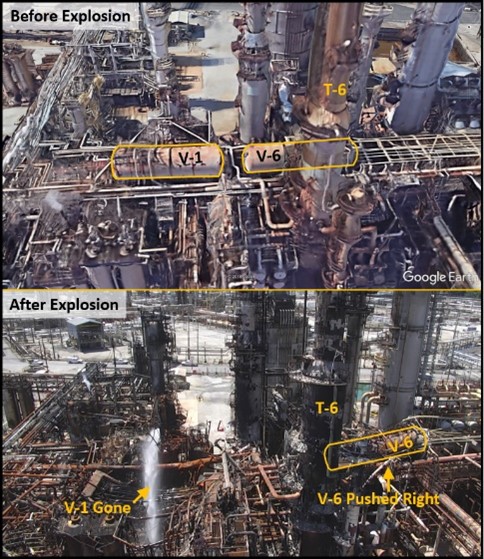The U.S. Chemical and Safety and Hazard Investigation Board (CSB) (Washington, D.C., USA) released its final investigative report into a massive fire and explosions at the Philadelphia Energy Solutions (PES) Refinery in Philadelphia, Pennsylvania, USA that occurred in June 2019.
The incident occurred when a corroded pipe elbow ruptured, releasing process fluid into the refinery’s hydrofluoric acid (HF) alkylation unit.
During the incident, over 5,000 lbs. (2,268.0 kg) of highly toxic HF were released, a 38,000-lb. (17,236.5-kg) vessel fragment launched off-site and landed on the other side of the Schuylkill River, and resulted in an estimated damage loss of $750 million.
“This is one of the largest refinery disasters worldwide in decades in terms of cost,” says CSB Interim Executive Authority Steve Owens. “The local community in Philadelphia fortunately was not seriously harmed, but given the refinery’s location, it could have been much worse. This incident should be a wake-up call to industry to prevent a similar event from occurring in the future.”
The CSB’s investigation determined that more than 117,000 people reside within a mile of the PES Refinery, according to U.S. Census data.
The CSB’s investigation identified several safety issues which contributed to the incident:
- Mechanical integrity: The CSB determined that the pipe elbow that failed had corroded faster than other piping in the HF alkylation unit. That is because the steel pipe elbow contained a higher content of nickel and copper than other piping in the unit.
- Verifying safety of equipment after changes to good practice guidance: When the pipe elbow was initially installed in 1973, the standard set by the American Society for Testing and Materials (ASTM) for carbon steel piping did not specify limits on nickel or copper content. Over the next decades, that standard changed—by 1995, the ASTM standard had been revised enough that the pipe elbow no longer met the organization’s requirements due to the elbow’s high levels of nickel and copper.
“A comprehensive evaluation of unit piping never occurred despite regulations from both the Occupational Safety and Health Administration (OSHA) and the Environmental Protection Agency (EPA) requiring companies to determine that their equipment is safe to operate after industry standards are updated,” says CSB Supervisory Investigator Lauren Grim.
“To prevent catastrophic incidents, companies and industry trade groups must ensure process safety when new knowledge on hazards is published,” she adds.

Remotely Operated Emergency Isolation Valves
The CSB found that there were no remotely operated emergency isolation valves installed in the HF alkylation unit to isolate nearby hydrocarbon sources that could then flow through the failed elbow. These valves are not explicitly required by the current American Petroleum Institute (API) standard on Safe Operation of Hydrofluoric Acid Alkylation Units, also known as API Recommended Practice (RP) 751.
However, if PES had installed such valves, the release from the pipe elbow could have been minimized and the subsequent explosions could have been prevented.
As a result, the CSB is recommending to API that it update its standard on API RP 751 to require installation of remotely operated emergency isolation valves on the inlets and outlets of all hydrofluoric acid containing vessels, as well as any hydrocarbon containing vessels meeting defined threshold quantities.
Safeguard Reliability in HF Alkylation Units
On the day of the incident, pumps designed to spray large volumes of water to suppress an HF release failed to activate early as the elements to remotely operate the pumps were damaged by the fire and explosions. Forty minutes elapsed from the time the release began before a worker was able to manually turn on a water pump.
In the meantime, highly toxic HF escaped from equipment and vaporized into the air. As a result, the CSB is recommending to API that it update its standard on API RP 751 to require that critical safeguards and associated control system components be protected from fire and explosion hazards, including radiant heat and flying projectiles.
Inherently Safer Design
Of the 155 U.S. petroleum refineries currently in operation in the U.S., 46 operate HF alkylation units. HF is highly toxic and one of the eight most hazardous chemicals regulated by the EPA’s Risk Management Program (RMP). Alternative alkylation techniques have been developed, such as a solid acid catalyst and new ionic liquid acid catalyst alkylation technology. Replacing highly toxic chemicals with less hazardous chemicals is an “inherently safer design” approach.
Additionally, some refinery alkylation units use sulfuric acid as a catalyst instead of HF.
Although sulfuric acid is highly corrosive and can cause skin burns upon contact, it remains a liquid upon release and does not present the same risk to surrounding communities as HF, which vaporizes upon release and has the potential to travel offsite.
The CSB’s investigation found that there is no federal regulatory requirement for refineries to analyze inherently safer design strategies to reduce the risk of serious accidental releases. Technologies are being developed that could be safer alternatives to HF alkylation, and refineries should periodically evaluate these available alkylation technologies.
Therefore, the CSB is recommending that the EPA:
- Require petroleum refineries to conduct a safer technology and alternatives analysis as part of their Process Hazard Analysis under EPA’s RMP rule, as well as evaluate the practicability of any inherently safer technology; and
- Initiate prioritization under the Toxic Substances Control Act (TSCA) to evaluate whether hydrofluoric acid is a high priority substance for risk evaluation; if it is, a TSCA risk evaluation of HF should be conducted and any identified risk mitigation requirements should be implemented.
Says CSB Board Member Sylvia Johnson, “The CSB wants to make sure that regulators are requiring companies to explore, determine, and utilize the safest technology available. Understanding and mitigating the risk of using highly toxic chemicals such as HF is good for communities, workers, and industry.”
Source: U.S. Chemical and Safety Board, www.csb.gov.
This article was originally published in the December 2022 print edition of Materials Performance. Republished with permission.